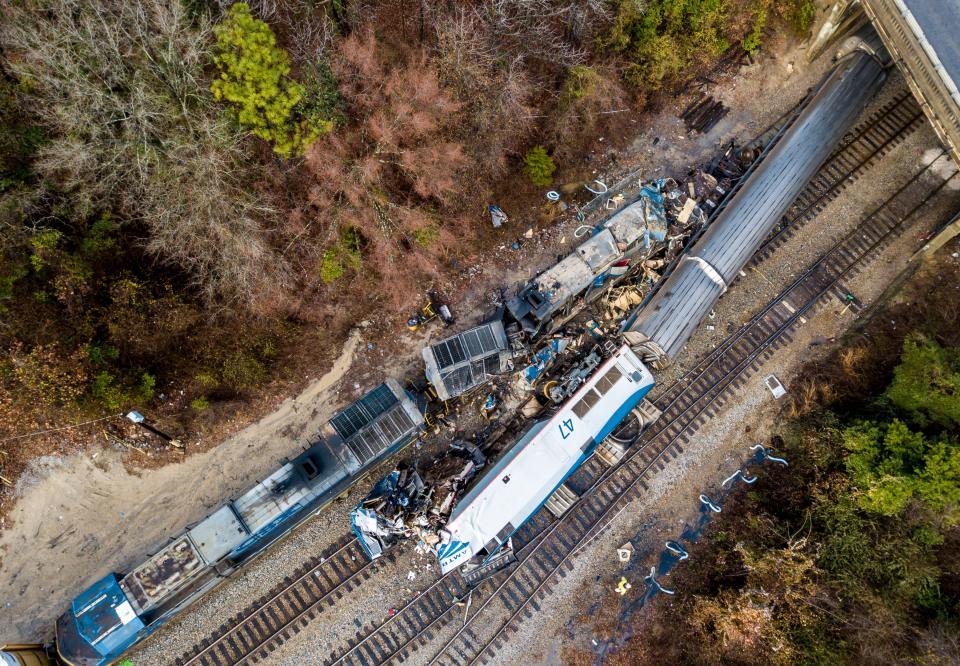Amtrak crash: Why train rammed into CSX freight cars, killing 2 and injuring 91, per NTSB

A fatal Amtrak train accident in South Carolina that killed two and injured 91 happened because work on the tracks led to a conductor failing to move a hand-thrown switch that would have prevented the crash, the NTSB said Monday.
The National Transportation Safety Board found that the conductor with freight operator CSX Transportation didn't move the switch to keep the Amtrak train on the main track in Cayce. Instead, the Miami-bound passenger was diverted onto another track as it barreled along at 53 miles per hour at 2:27 a.m. on Feb. 4, 2018 and piled into a parked freight train.
More: Illinois train derailment sends plumes of smoke, flames into sky seen for miles
Two of the Silver Star train's seven cars jackknifed. The collision killed the Amtrak train's engineer and conductor, who had tried to apply the emergency brake the train at the last minute. The crash caused more than $25 million in damage.

Ironically, the normal system of track signals had been suspended due to a project to install what is known as "positive train control," a system that uses computers and GPS to warn engineers of other trains or trouble on the tracks ahead.
But a substitute system of orders had been issued for switching. A CSX worker reported having made the switch, although the signal in question lacked a red-and-green marking that would have made it easier to see if it was in the wrong position.
In its report, the NTSB spread the blame around. It said the CSX didn't compensate fully for the risks associated with suspending the signal system, eliminating redundancies that normally would ensure switches were in the proper position. Amtrak, too, should have conducted a risk assessment before the signal suspension went into effect.
More: Investigators access data recorders in N.J. train crash
The Federal Railroad Administration, the federal agency that governs the nation's railroads, failed to assess and mitigate the risk from improper switching, the report said.
In response to the report, Amtrak said in a statement that it is "deeply saddened" by the loss of the two employees and that it will work with the NTSB to address its recommendations. It said it has taken steps, such as hiring a train safety expert, working to install positive train control across its network, and implementing a safety management system, and as called for in the report, risk assessment during signal suspensions.
The CSX freight engineer and conductor were jointly responsible for making sure the switch had been thrown to keep on the Amtrak trains on the main track when coming through the rail yard.
"According to the engineer, he questioned the conductor on the position of the main track switch several times after both of them had sat in the locomotive cab 10 to 15 minutes. Therefore, he should have had the conductor verify the position of the switch, and both of them should have immediately contacted the dispatcher to advise him that they would need to verify the switch position." the NTSB report said.
More: Amtrak reveals details about nonstop New York-D.C. service, new sleeping train amenities
Instead, the conductor handed over authority for the tracks to a CSX train dispatcher about a half-hour before the crash. The main-track switch hadn't been thrown.
"At the time of the collision," the NTSB said, "the CSX conductor was under the impression that he had successfully realigned all the switches, and it was only later, after thinking about the incident that he realized he had made a mistake."
CSX, in a statement, said it made safety improvements after the crash in Cayce, including enhancing rules and processes around signal suspensions. It also made safety improvement with Amtrak after the accident and is pushing ahead with the positive train control system, which will include Amtrak.
This article originally appeared on USA TODAY: Amtrak crash: NTSB finds improper switching to blame.

